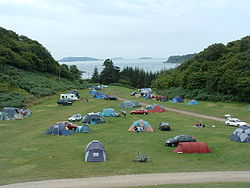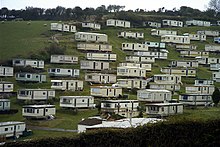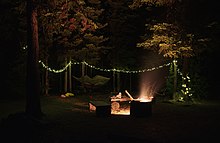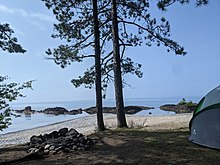
Utah Lake State Park is a state park in Provo, Utah, United States. The park is located at the west end of Provo Center Street on the east shore of Utah Lake and immediately northwest of the Provo Municipal Airport.

Camping is a form of outdoor recreation or outdoor education involving overnight stays with a basic temporary shelter such as a tent. Camping can also include a recreational vehicle, sheltered cabins, a permanent tent, a shelter such as a bivy or tarp, or no shelter at all. Typically, participants leave developed areas to spend time outdoors, in pursuit of activities providing them enjoyment or in a form of educational experience. Spending the night away from home distinguishes camping from day-tripping, picnicking, and other outdoor activities.

A recreational vehicle, often abbreviated as RV, is a motor vehicle or trailer that includes living quarters designed for accommodation. Types of RVs include motorhomes, campervans, coaches, caravans, fifth-wheel trailers, popup campers, and truck campers.

A caravan, travel trailer, camper, tourer or camper trailer is a trailer towed behind a road vehicle to provide a place to sleep which is more comfortable and protected than a tent. It provides the means for people to have their own home on a journey or a vacation, without relying on a motel or hotel, and enables them to stay in places where none is available. However, in some countries campers are restricted to designated sites for which fees are payable.

A campervan, also referred to as a camper, caravanette, motorhome or RV in North America, is a self-propelled vehicle that provides both transport and sleeping accommodation. The term describes vans that have been fitted out, whereas a motorhome is one with a coachbuilt body.
Mistletoe State Park is a 1,972 acre (7.98 km²) Georgia state park located northwest of Augusta, Georgia on the southern shore of Lake Strom Thurmond. The park gets its name from Mistletoe Corners, a local area where people gather to pick mistletoe during the winter holiday season. Its strategic location on the lake makes it one of the finest bass fishing spots in the nation. The park also offers public beaches and 8 miles of nature trails. The land on which the park is located is leased to Georgia by the United States Army Corps of Engineers.

A recreational vehicle park or caravan park is a place where people with recreational vehicles can stay overnight, or longer, in allotted spaces known as "sites" or "campsites". They are also referred to as campgrounds, though a true campground also provides facilities for tent camping; many facilities calling themselves "RV parks" also offer tent camping or cabins with limited facilities.

Bon Echo Provincial Park is a provincial park in southeastern Ontario, Canada, approximately 6 kilometres (3.7 mi) north of Cloyne. The park is within township boundaries of both North Frontenac and Addington Highlands, roughly separated by Highway 41.

Disney's Fort Wilderness Resort & Campground is a themed camping resort located in the Magic Kingdom Resort Area at the Walt Disney World Resort in the U.S. state of Florida. It officially opened on November 19, 1971. The resort is situated adjacent to Bay Lake, near Disney's Wilderness Lodge. It also formerly contained Disney's River Country, a water park which closed on November 2, 2001.

Big Meadows is a recreational area of the Shenandoah National Park in Madison County and Page County, in the US state of Virginia. The meadow is located on the Skyline Drive at Milepost 51 and contains the park's Harry F. Byrd Visitor Center, a lodge, camp store, and camping area. Several hiking trails can be accessed from Big Meadows, including the Mill Prong Trail which leads to Rapidan Camp on the Rapidan River, the fishing retreat of President Herbert Hoover from 1929–1933, which is now restored to its 1930s configuration.

Golden Ears Provincial Park is a 555.9 square kilometres (214.6 sq mi) provincial park in British Columbia, Canada. It is named after the prominent twin peaks, which are commonly referred to as Golden Ears. The park was originally part of Garibaldi Provincial Park but was split off as a separate park in 1967. The area was logged extensively in the 1920s by the Lougheed and Abernathy Logging Company. Many recreational attractions are found within the park. Golden Ears Provincial Park is a protected area that contains many endangered species of flora and fauna.

Mark Hammerton Group Ltd was a UK-based travel organiser and travel publisher specialising in camping, caravanning, motorhome and mobile home holidays on campsites in France, Spain, Italy and other European countries. The Group published the market-leading Alan Rogers campsites guides and offered a European travel service for readers including ferry bookings. The Group was acquired by The Caravan Club in 2012 under the brand Alan Rogers Travel Group, along with its subsidiary company Belle France, which offers walking and cycling hotel holidays.
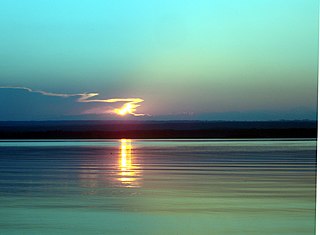
Meadow Lake Provincial Park is a northern boreal forest provincial recreational park along the Waterhen and Cold Rivers in the Canadian province of Saskatchewan. The park was founded on 10 March 1959, is the largest provincial park in Saskatchewan, and encompasses over 25 lakes in an area of 1,600 km2 (620 sq mi). The park was named "Meadow Lake" after the city of Meadow Lake and Meadow Lake. The city and the lake are not in the park and are located about 40 kilometres (25 mi) south-east of the nearest park entrance, which is about 5 kilometres (3.1 mi) north of Dorintosh. The length of the park stretches about 113 kilometres (70 mi) from Cold Lake on the Saskatchewan / Alberta border in the west to the eastern shore of Waterhen Lake in the east.
SMONEĆTEN Campground is located in the town of Sidney on Vancouver Island, British Columbia. SMONEĆTEN Campground is 20 hectares of forested parkland and can be accessed from the Pat Bay Highway. Previously, SMONEĆTEN Campground was managed by the province of British Columbia and known as McDonald Campground. Today SMONEĆTEN Campground is a part of Gulf Islands National Park Reserve. The campground was renamed to SMONECTEN in 2021.
DuPuis Management Area is a 21,875 acre protected area in northwestern Palm Beach County, Florida and southwestern Martin County, Florida. Recreational opportunities include hunting, horseback riding, cycling, camping, hiking, auto touring, and fishing. During hunting periods it is closed to other use. The property includes a visitor center. Dogs are not allowed on the property. The park includes 22 miles of hiking trails, including a stretch of the Ocean to Lake Trail. There is also an equestrian campground and 40 miles of horseback riding trails. The park is located off State Road 76. It is along the Ocean to Lake Trail.
Bomoseen State Park is a 3,576-acre state park in the towns of Castleton, Fair Haven, Hubbarton and Benson, Vermont. The park is located in the Taconic Mountains on the western shore of Lake Bomoseen.
The term recreational vehicle (RV) is often used as a broad category of motor vehicles and trailers which include living quarters for designed temporary accommodation. Types of RVs include motorhomes, campervans, caravans, fifth-wheel trailers, popup campers, truck campers and Park Model RVs.

Dispersed Camping is the term given to camping in the United States on public land other than in designated campsites. This type of camping is most common on national forest and Bureau of Land Management land. Designated campsites often offer services to the campers, such as trash removal, toilet facilities, tables and/or fire pits, which are not available at dispersed camping locations. Although dispersed camping takes place on public land, each managing agency has specific regulations for dispersed camping, though they generally all also require campers to follow Leave No Trace guidelines. In addition, some public lands restrict camping to 14 days. Other terms used for this type of camping can be boondocking, dry camping or wild camping.

Rocky Knob Recreation Area is a 4,500 acres (18 km2) recreation area along the Blue Ridge Parkway, which spans from mile markers 167–174. The park is home to 15 miles of hiking trails, 81 tents camping sites, 28 RV sites, and 72 picnic sites. The campground is open seasonally, typically from May–October. Rocky Knob is also home to Rock Castle Gorge, a 3,500 acres (14 km2) gorge, and home to the Rock Castle Gorge National Recreation Trail. The trail drops 1,000 feet in elevation in 3 miles, and backpackers can request a backcountry camping permit from the National Park Service.



